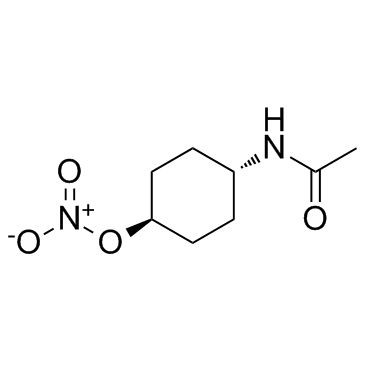137213-91-3
| Name | (4-acetamidocyclohexyl) nitrate |
|---|---|
| Synonyms |
Acetamide,N-[trans-4-(nitrooxy)cyclohexyl]
BM121307 |
| Description | BM121307 is a guanylate cyclase activator that was in phase I development for the treatment of ischaemic heart disorders. The research has been discontinued. |
|---|---|
| Related Catalog | |
| In Vivo | The elimination of BM121307 and its metabolites via urine and feces amount to 76.5% after oral application, and to 80.7% of the applied dose after intravenous application. The major amount of radioactivity is eliminated via urine (69.4% and 73.6% of the dose, respectively), whereas the fecal elimination is found to be negligible. Investigations of the urinary samples show that the drug is metabolized to a high percentage trans-N-(4-Hydroxycyclohexyl) acetamide is the main metabolite; 73% of the radioactive compounds (after p.o.-administration and 69% after intravenous application could be identified as the alcohol of BM121307; the amounts of the drug totaled 9% and 13%, respectively[1]. |
| Animal Admin | Dogs[1] The biotransformation of BM121307 in the dog is examined after oral and intravenous administration. For that purpose, the organic nitrate is synthesized as radioactive [14C]- and as [13C]-labeled compounds. The defined isotopic mixture is administered to the dogs. Within the examined period of 168 h, the elimination of BM121307 is measured[1]. |
| References |
| Density | 1.2g/cm3 |
|---|---|
| Boiling Point | 378.8ºC at 760mmHg |
| Molecular Formula | C8H14N2O4 |
| Molecular Weight | 202.20800 |
| Flash Point | 182.9ºC |
| Exact Mass | 202.09500 |
| PSA | 87.64000 |
| LogP | 2.00550 |
| Vapour Pressure | 6.12E-06mmHg at 25°C |
| Index of Refraction | 1.492 |
